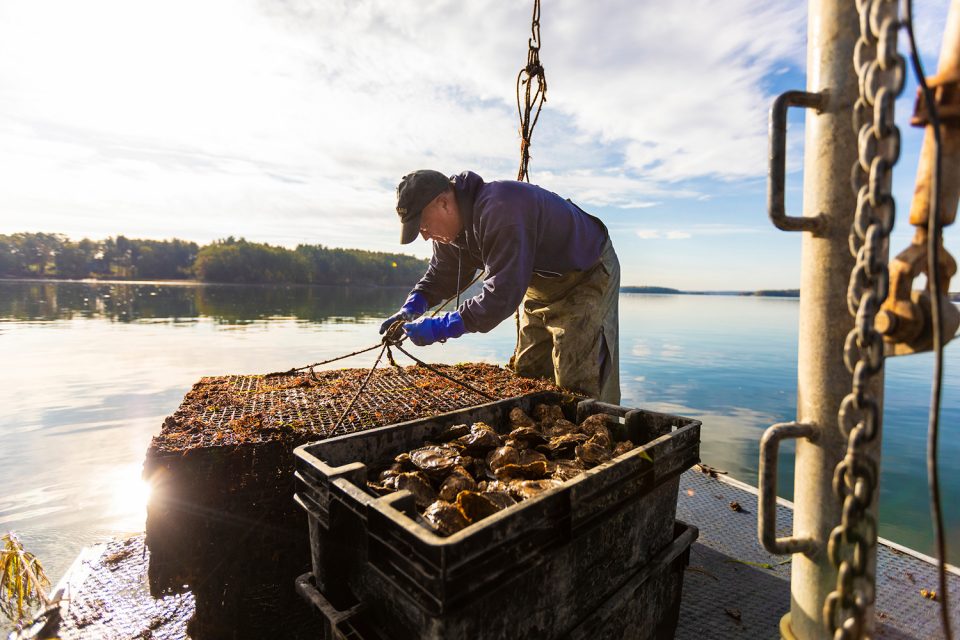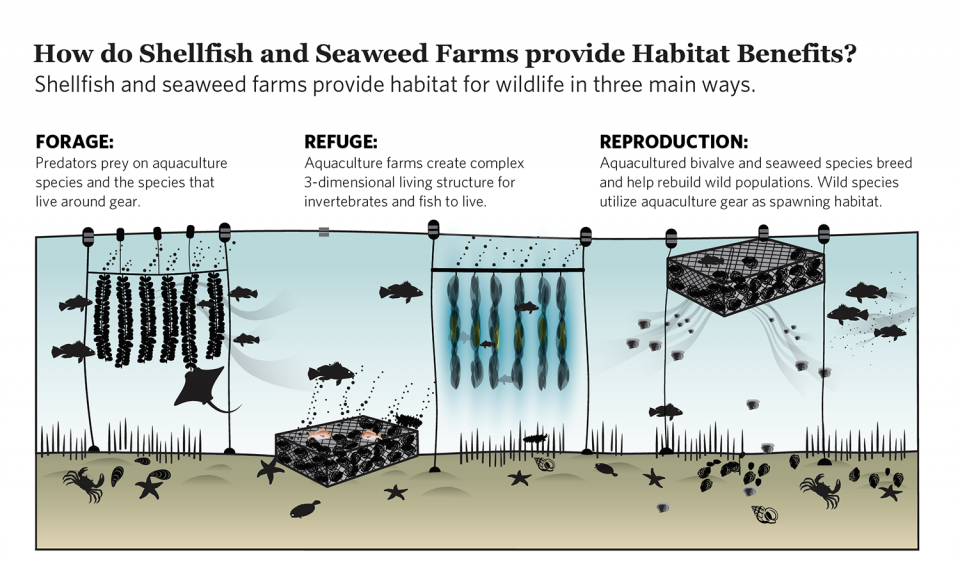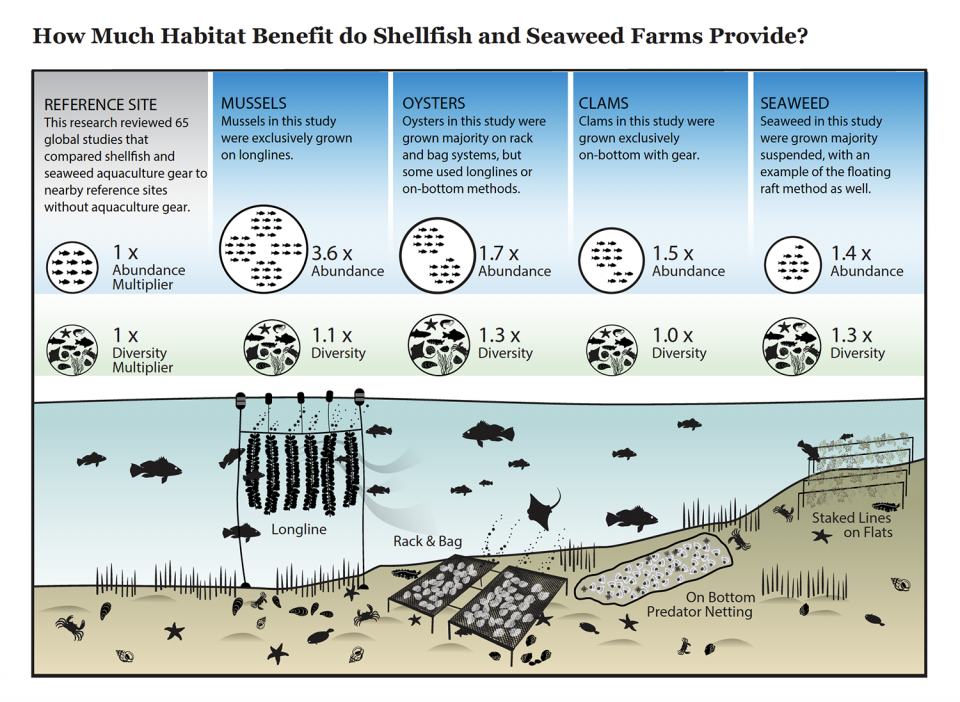Conservation group touts bivalve and seaweed farms as critical components of beneficial food systems

U.S. conservation group The Nature Conservancy (TNC) today released a meta-analysis of existing research literature that has determined that restorative or regenerative aquaculture – seaweeds and bivalves – not only improves surrounding ecosystems but also contributes to healthier marine animal habitats and biodiversity.
Titled “Habitat value of bivalve shellfish and seaweed aquaculture for fish and invertebrates: Pathways, synthesis and next steps,” the study was published in the journal Reviews in Aquaculture. Robert Jones, global aquaculture lead at TNC and one of the study’s authors, told the Advocate that the review of 65 published sources – which he called a form of “global synthesis science” – is the first of its kind to review and consolidate data around the idea of restorative aquaculture.
“Can we show that these farmers are having a positive benefit on the environment? That was the objective,” said Jones. “It seems somewhat counterintuitive, because in land-based systems, it’d be rare to find an example of placing a farm somewhere and improving wildlife habitat. But people familiar with the ocean understand that structure in the ocean can generate a habitat effect, like with artificial reefs. But aquaculture is a living system, and there can be more benefits than just the structure itself.”
A lot of the findings in these studies had been “buried in the literature,” he said, so TNC set out to centralize the information.
https://www.aquaculturealliance.org/advocate/tnc-encourage-capital-issue-guidance-sustainable-aquaculture-investment/
TNC collaborated with its partners at the University of Melbourne, the University of Adelaide (both in Australia) and the University of New England (Maine, USA) to assess the biodiversity benefits of mussel, oyster, clam and seaweed farms. In each case, a greater number of fish and invertebrates were observed on the farm sites in comparison to nearby locations, with mussel farms showing the greatest ability to act as an aggregator of marine life. In fact, mussel farms attract about 3.6 times more fish and invertebrates than nearby locations.
“Earlier on, our research was focused on mapping out potential ecosystem benefits of aquaculture, making a high-level case for it. Then upon digging in, we found issue areas and three really strong cases for restorative aquaculture,” said Jones. “One is water quality and [excess] nutrient removal – that’s the one we have the best handle on. There’s another body of emerging information around climate and carbon sequestration. That’s an area we’re digging into too and will have more on later this year. The third is habitat. The benefits of biodiversity [surrounding aquaculture farms] is not as well understood.”

The TNC report also shows that oyster farms proved effective at increasing biodiversity, as 30 percent more species were found to inhabit oyster farms than surrounding areas. Marine farms, Jones said, are good at providing reproductive and foraging grounds as well as shelter from predators.
“Food production has had a significant negative impact on the natural world, including 80 percent of habitat loss, and aquaculture alone accounts for up to 30 percent of mangrove loss in some parts of Asia, which are vital nursery grounds for fish and marine life,” said Dr. Heidi Alleway, global aquaculture scientist at TNC. “As a result, conservation efforts have been increasingly focused on how to curb the detrimental effects of food production practices. The benefits identified in this study open an exciting conversation about how we might be able to better design – to best design – a food system that not only addresses the environmental impacts, but perhaps even supports the repair and recovery of degraded ecosystems or areas.”

The authors want policymakers at local, regional and global levels to recognize the potential of aquaculture and to incorporate it into regulatory systems. They hope shellfish and seaweed farming systems can inspire application and development of aquaculture and agriculture that is “nature-positive” and assisting food security efforts.
“We were able to show for the first time, conclusively, that [seaweed and shellfish farms] do tend to have a positive impact on the abundance of marine life and the diversity of marine life,” Jones said, stressing that not every farm examined in the literature met the criteria as a net environmental benefit. “Biodiversity is the essence of ocean health. If animals living in it are healthy, there’s an inherent benefit for a functional ocean ecosystem but there are implications for humans as well if we utilize these animals as food sources.”
Follow the Advocate on Twitter @GAA_Advocate
Now that you've finished reading the article ...
… we hope you’ll consider supporting our mission to document the evolution of the global aquaculture industry and share our vast network of contributors’ expansive knowledge every week.
By becoming a Global Seafood Alliance member, you’re ensuring that all of the pre-competitive work we do through member benefits, resources and events can continue. Individual membership costs just $50 a year. GSA individual and corporate members receive complimentary access to a series of GOAL virtual events beginning in April. Join now.
Not a GSA member? Join us.
Author
-

James Wright
Editorial Manager
Global Aquaculture Alliance
Portsmouth, NH, USA

